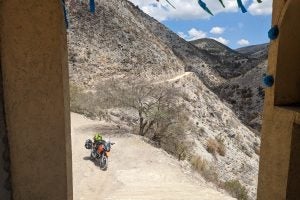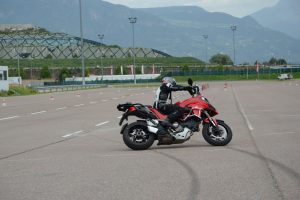“If I don’t practice for a day, I don’t hear a difference. If I don’t practice for two days, I’ll hear a difference. If I don’t practice for three days, you’ll hear a difference.” These words from a professional cellist speaking of the performance falloff that occurs after a (very) brief period of inactivity. To play at a level that gets you a gig in a big-city symphony is no easy task. This cellist, from about the age when I believed girls were yucky, had put in the hours at the conservatory to play well enough to have a shot at making a living from doing it. This investment of thousands of hours of practice has nothing to do with the notion of an artistic “gift.” It’s just the inescapable grunt work to get a level to determine if a player has the intonation, musicality, and imagination to make Bach’s Cello Suites soar. Which got me thinking. About motorcycling.
Those of you who’ve endured a high-school band performance may disagree, but no one’s ever died from listening to a poorly played trombone. What’s my point? Motorcycles are inherently dangerous vehicles (our mothers had it nailed) and yet we put far less effort into developing and maintaining our riding skills than even a so-so musician invests into their playing. Most of us—and I include myself—unnecessarily risk our lives because we’re fumbling at the controls of a motorcycle with a skillset that rivals that of a timpanist who can’t work out the timing on when to club the kettle drum.
Our ineptitude at the controls is reflected both in mortality rates from crashes—recent numbers on motorcycle accidents show that the majority of deaths are self-inflicted and have nothing to do with wayward motorists—and sky-high insurance rates. It’s the latter that recently motivated an insurance company to partner with a long-time racer and riding instructor to try to reverse the trend by hosting a training day for street riders. I’m as wary of insurance-company largess as I am of financial institutions or telecommunications giants aligning with social causes, but I’ll gladly—if temporarily—suspend my disbelief if I’m invited to a training session that includes time on a racetrack.
As the 40-strong participants congregated in the parking lot behind the grandstands, it was clear organizers succeeded in gathering a broad cross-section of riders. My Ducati 900SS was slotted alongside a BMW R1300 GS, a blinged-out Harley bagger, an Aprilia RSV4 and a Honda Transalp. But before we hit the track, we sat for an hour of classroom instruction. And this is where things got confusing.
Teaching concepts that we feel we intuitively understand creates a world of misunderstanding. Had your parents tried to inform you about the theories behind counter-steering when you were learning to ride your first two-wheeler you’d have run back to your baseball mitt convinced bicycles were beyond your five-year-old skillset. Or, as was the case in our classroom session, your whatever-age-you-are skillset. As the instructor addressed counter-steering, I looked around the room at a collection of furrowed brows. I wasn’t surprised.
One of the peculiarities about humanity is that we’d rather debate, discuss, opine or rant about a theory than actually test the hypothesis. Does drinking goat milk cure hangovers? You’d think it’d be self-evident that the way to find out would be to get drunk and then, the next morning, drink goat milk. But no, for reasons inexplicable to me, we’d rather ask someone else who’s never tried it if they think it’ll work.
I was gobsmacked when an acquaintance, a longtime rider, told me the primary way to turn a motorcycle was by weighting footpegs—to turn right you push with your right foot and to turn left you push with your left foot. This is simply not true. And I know because the next time I was on a bike, I tried it. Which isn’t to say weighting footpegs isn’t in the arsenal of an advanced rider. But, on its own, weighting footpegs does next to nothing to turn a motorcycle. What struck me as peculiar about the exchange is that this rider is no dabbler. She’s ridden thousands of miles. With virtually no confidence. Crosswinds terrify her. She’s dangerously slow. I suspect she’s never given either end of her handlebar a good shove just to see what would happen.
Once we hit the racetrack on our training day, for a series of drills that included weaving between pylons and hard braking, it was easy to see who knew how to turn a motorcycle and who didn’t. Chaps-wearing Harley riders gracefully slalomed through pylons while riders on far more agile equipment struggled. A surprising number of riders flung their shoulders side-to-side as they navigated the slalom as if they were trying to toss themselves off a mechanical bull. The more I thought about it, the more confusing this became to me. How can you ride a two-wheeler and not understand the physics of it?
We all started out on bicycles. And bicycles, because of lightness, skinny tires, and slow speeds, don’t need much provocation to turn corners on roads designed for cars. We countersteer bicycles without an awareness we’re doing so. A bicycle just seems to “fall” into corners. And that’s how a surprising number of motorcyclists turn—they ride so daintily the machine gives the rider the perception that it’s effortlessly dropping into a corner. Allied with the simplicity of turning the vehicles—cars—we spend most of our time in (turn right go right, turn left go left) and our counterintuitive views toward countersteering almost make sense. Almost.
Unless you intuitively grasp the concept of how a motorcycle works, you’re forever destined to struggle. And this lack of understanding leads to both a misunderstanding of how a motorcycle turns and fear of the lean angle that accompanies a turn. Does it sound ludicrous to imagine an airplane pilot fearful of banking a plane into a turn? Of course it does, because that’s how airplanes turn. Is motorcycling any different? On the training day, over and over again, I watched riders fearful of leaning a bike into a turn. As if leaning a bike had nothing to do with turning a corner and everything to do with instigating unnecessary risk.
Last night I rode the old Ducati up the escarpment then down into the beaver valley. To a curvy, empty road. And I practiced. I kept my eyes up. I rounded corners and pretended there was a washing machine sitting in my lane I had to simultaneously brake hard and turn to avoid. At first, I was tentative. On my fifth or sixth time performing the drill I was swift and sure. Then I rode at 80 mph—my usual cruising speed—and braked as hard as I could. Again and again. And came to a stop in shorter and shorter distances. On the ride home, I felt like a better, more aware, more capable rider with a large, looming question—why hadn’t I done this years ago? Why had I been satisfied with my community-orchestra skillset when focused effort could have made me principal violinist with the New York Philharmonic?







